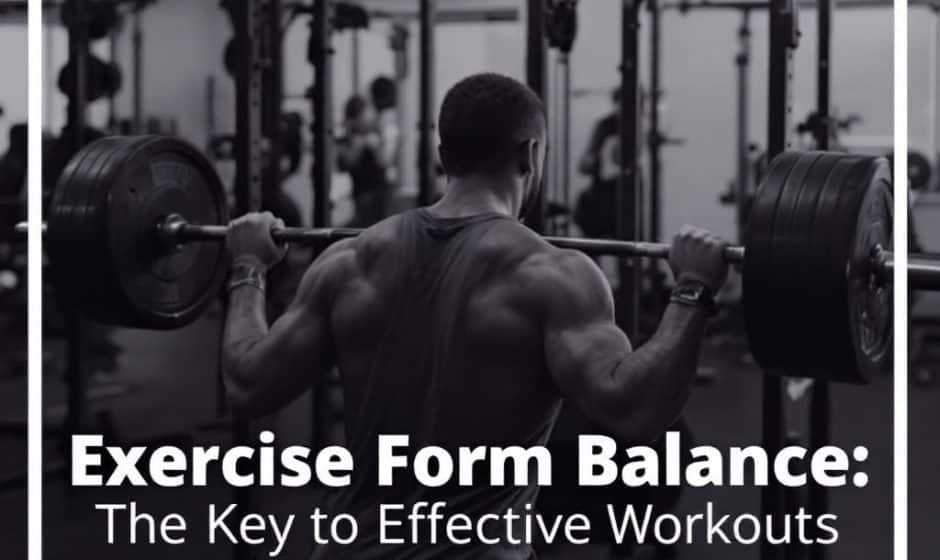Let me paint you a scenario we’ve all experienced – you’re at the gym, ready to dive into your workout. You watch someone absolutely crushing those deadlifts. They’re confident. You think, “I’ve got this” and load up the bar. But wait, as you start your lift, something feels off. You’re not entirely sure if your back should feel that way. Sound familiar?
Understanding Exercise Form and Why It Matters
Let’s dive in and set things straight, right from the jump. Exercise form is your technique or how you perform each movement during your workout. It’s not just something trainers nag about—it’s essential, my friend. Good form ensures you’re not allowing ego to dictate abnormal hormone regulation during stress-induced workouts. Poor form risks injury, while proper form balances those muscle gains. Who wouldn’t want that?
Now, here’s the kicker. Good form isn’t just about preventing injuries, although that’s pretty important too. It’s also about maximizing those hormone regulators and getting the most bang for your buck out of every single scorching set and painful rep.
Why Balanced Hormone Regulation is Your Best Friend
When we exercise, our bodies experience stress. That’s good stress, in the right dose! This stress triggers our body’s hormone regulation system, releasing endorphins like we’re rightful owners of a perpetual mood boost. Here’s the rub—exercise too little or too much, and this regulation skews, leaving us tired or unnecessarily jittery. Balanced form lets you manage your effort more effectively. Trust me on this.
The Building Blocks of Exercise Form
Interested in getting those form building blocks right from the get-go? No worries, I’ve got you covered:
1. Alignment is Everything

Start with aligning your body. Your bones should support the moves you’re making. Imagine there’s a rod going straight from your head down to your tailbone when doing planks or squats. The idea – let your skeleton take some pressure off your muscles.
2. Control Your Pace
Rushing through exercises is the first class ticket to wild hormone swings and imbalance. Slow it down. Control equals more time under tension, which optimizes hormone regulation and gives you those lean, mean muscles.
3. Breathing Matters More Than You Think
Remember to breathe. Seriously—don’t forget! Inhale on the easy part of the movement and exhale on the effort. Breathing eases hormone production, maintaining balance across different systems.
Now, Let’s Bust Some Myths
So what about some common misconceptions about exercise form that might have us all scratching our heads? Let’s set some records straight.
**Myth: More Reps, Better Results.** Nah, not always. Quality form beats quantity any day. If executing one perfect push-up is more challenging than ten flops, the single proper rep engages muscles to aid better hormone distribution.
**Myth: Weights are Just for, Well, Just Muscles.** They actually help regulate your hormones. Resistance work, performed with the proper form, facilitates complex hormonal homeostasis.
How to Spot Faulty Exercise Form
You might be thinking, “How do I know when I’m doing it wrong?” It’s that discomfort we conveniently ignore. Internal alarm bells should ring if you feel pain (not to be confused with a burning workout). Consider these red flags:
- Sway Backs or Arched Posture: Pain here.
- Knee Caving in Leg Workouts: Bad joints days coming soon.
- Raised Shoulders during Lifts: Seriously, relax those shoulders.
Consider visiting with a professional trainer to get that form check now and again. It helps!

Actionable Steps to Work on Your Form
Okay, onto the fun part—what can you actually *do* about your exercise form? Here are some tips that even veteran gym-goers revisit:
Get Visual
No shame in watching some technique videos. In fact, filming your workout can provide valuable insight into mistakes. You see yourself in real-time and, surprisingly, it’s a bit comedic too—nothing wrong with learning and laughing.
Partner Up
Get an exercise buddy. They’re not just your cheerleader—they can help adjust your form when needed.
Use Equipment Wisely
Ever notice those mirrors? They’re not just vanity props. Use them. From deliberate gentle movements like yoga to rough and rattling weightlifting sessions, they ensure you hold positions that balance muscle-y hormone synthesis.
Practice Consistency Over Perfection
You’ve got to keep working on it—consistently. Rather than obsessing over being picture-perfect, nail the basics consistently. Each rep builds muscle memory essential for crafting a stable hormonal environment.

Common Mistakes and How to Avoid Them
I’d say these are pitfalls, but who hasn’t slipped once or twice?
- Neglecting Warm-Ups: Save your muscles and hormone harmony by actually warming up.
- Ignoring Core Strength: Your core tightly wraps around essential hormone producers.
- Forgetting Cooling Down: Don’t just rush through. Cooling down solidifies the muscle memory.
Hormone Regulation: The Hidden Gem of Fitness
Let’s talk about this cornerstone that’s glossed over: hormone regulation. How you adapt to this intricate internal symphony hits the core of effective workouts. Good form sustains proper integration of this biology, allowing smooth transitions from fat-burning modes to muscle growth peaks.
The “Exercise Form—Hormone Synergy”
Not only are we like conductors charting our hormones with thought-out rep placement, but it organically powers recovery and moods. The cycle’s cleansing and addictive when executing movements perfectly. Careful form encourages this rhythm.
Putting It All Together
So look, no one’s expecting you to leave today as a human anatomy encyclopedia. But mastering exercise form? That’s a continuous jam that just keeps getting better as you groove along. It’s like learning to ride a bike, except instead of just going faster, you’re getting healthier in ways you didn’t notice until you stepped back.
Focus on the finesse of movement, align yourself physically and hormonally, and don’t sweat it if you don’t get it spot on every single time. Because guess what? Each moment you invest in understanding your own rhythm, it pays off big time.
Give your body time to unlearn bad habits and learn good ones, keeping awareness tight in each thrilling exploration. Exercise is personal work. Once finely balanced form tames errant hormones, they rejoice and elevate you way farther than you thought initially possible.
Need any encouragement? You’re not alone. We’re all in this work, striving bit by bit to not just work out but work right. Aim for balance, add the right pinch of discipline, and trust me, you’ll be well on your way to even more rewarding workout here, again and again.
Frequently Asked Questions
What is hormone regulation, and how does it work?
Hormone regulation involves the balance and control of hormones in the body. Hormone replacement therapy (HRT), for example, works by topping up or replacing missing hormones, particularly during perimenopause and menopause when levels of oestradiol, progesterone, and testosterone decline. These hormones act as chemical messengers influencing every cell and organ in the body[1][3][5).
What are the common symptoms of hormonal imbalance?
Common symptoms of hormonal imbalance include irritability and fatigue, mood swings and depression, skin dryness and loss of elasticity, water retention and weight gain, osteoporosis and joint pain, less interest in sex, insomnia, and other sleep disorders, as well as memory issues and difficulty concentrating[3][5).
What are the different types of hormone replacement therapy (HRT)?
Hormone replacement therapy comes in various forms, including systemic hormone therapy (pills, patches, rings, gels, creams, or sprays), low-dose vaginal products (creams, tablets, or rings), and bio-identical hormone replacement therapy, which is structurally identical to human hormones and may have fewer side effects than traditional HRT[1][3).
What are the common side effects of hormone replacement therapy (HRT)?
Common side effects of HRT include bleeding, breast tenderness, bloating, and mood changes. These side effects are usually well-tolerated and often settle over time. If side effects persist, adjusting the dose or type of HRT may be necessary[1]).
References




